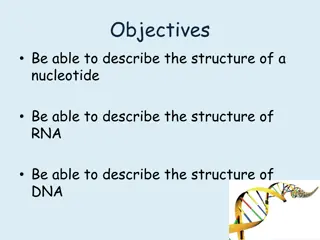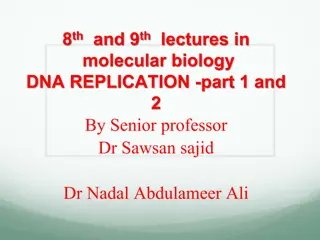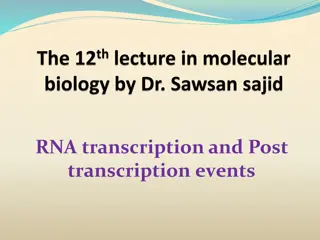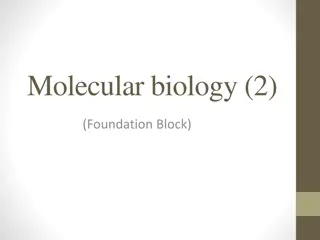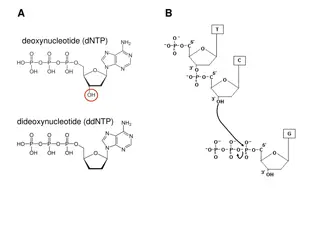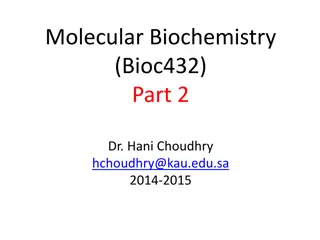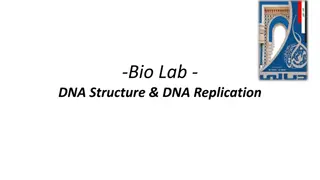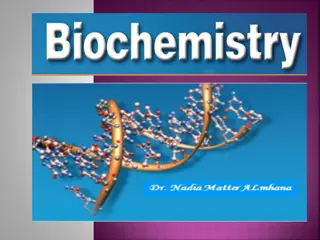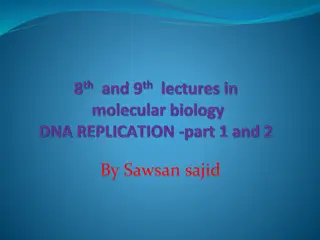Understanding the Mechanism of DNA Replication
Explore the intricate process of DNA replication, as elucidated by renowned scientists like Dr. R. C. Nath and Nobel laureate Arthur Kornberg. Delve into the essential enzymes, proteins, and basic rules involved in the replication of genetic material, shedding light on initiation, elongation, and termination phases.
Download Presentation

Please find below an Image/Link to download the presentation.
The content on the website is provided AS IS for your information and personal use only. It may not be sold, licensed, or shared on other websites without obtaining consent from the author. Download presentation by click this link. If you encounter any issues during the download, it is possible that the publisher has removed the file from their server.
E N D
Presentation Transcript
THE THE MECHANISM OF DNA MECHANISM OF DNA REPLICATION REPLICATION By Dr. R. C. Nath; Associate Professor Department of Zoology Govt. Degree College, DMR.
`It has not escaped our notice that the specific pairing we have postulated immediately suggests a possible copying mechanism for the genetic material Watson & Crick Watson & Crick Nature (1953) Nature (1953) Original drawing by Francis Crick
DNA replication 3 possible models
Basic rules of replication Basic rules of replication A. Semi-conservative B. Starts at the origin C. Synthesis always in the 5'-3'direction D. Can be uni or bidirectional E. Semi-discontinuous F. RNA primers required
What kind of enzyme synthesizes the new DNA strand? 1) RNA polymerase 2) DNA Polymerase 3) Primase 4) Helicase 5) Topoisomerase
Core proteins at the replication fork Core proteins at the replication fork Topoisomerases Topoisomerases Helicases Helicases Primase Primase Single strand Single strand binding proteins binding proteins DNA polymerase DNA polymerase Tethering protein Tethering protein DNA DNA ligase - Prevents torsion by DNA breaks - separates 2 strands - RNA primer synthesis - prevent reannealing of single strands - synthesis of new strand - stabilises polymerase - seals nick via phosphodiester linkage ligase
The mechanism of DNA replication Arthur Kornberg, a Nobel prize winner and other biochemists deduced steps of replication Initiation Proteins bind to DNA and open up double helix Prepare DNA for complementary base pairing Elongation Proteins connect the correct sequences of nucleotides into a continuous new strand of DNA Termination Proteins release the replication complex
Steps involved in DNA Replication in Prokaryotes (E.coli) In prokaryotes, the DNA is circular. Replication starts at a single origin (ori C) and is bi- directional and semi-conservative. The region of replicating DNA associated with the single origin is called a replication bubble or replication eye and consists of two replication forks moving in opposite direction around the DNA circle.
During DNA replication, the two parental strands separate and each acts as a template to direct the enzyme catalysed synthesis of a new com- plementary daughter strand following the base pairing rule. Three basic steps involved in DNA repli- cation are Initiation, elongation and termination.
I. Initiation Step 1:Binding of DNA around an initiator protein complex DNA-A ATP ~30-40. The DNA B or helicase unwinds ori C (origin of replication) and extends the single stranded region for copying. Step 2: Single strand binding protein (SSB) binds to this single stranded region to protect it from breakage and to prevent it from renaturing. As the parental DNA is unwound by DNA helicases and SSB (travels in 5 -3 direction),
the resulting positive supercoiling (torsional stress) is relieved by topoisomerse I and II (DNA gyrase) by inducing transient single stranded breaks. Step 3: The enzyme DNA primase (primase, an RNA polymerase) then attaches to the DNA and synthesises a short RNA primer to initiate synthesis of the leading strand of the first replication fork.
II. Elongation Step 4: DNA polymerase III extends the RNA primer made by primase. DNA polymerase possesses separate catalytic sites for polyme-risation and degradation of nucleic acid strands. All DNA polymerases make DNA in 5 -3 direc-tion Leading strand synthesis: On the template strand with 3 -5 orientation, new DNA is made continuously in 5 -3 direction towards the replication fork. The new strand that is continuously synthesized in 5 -3 direction is the leading strand.
Lagging strand synthesis: On the template strand with 5 -3 orientation, multiple primers are syn- thesized at specific sites by primase (primosome complex) and DNA pol III synthesizes short pieces of new DNA (about 1000 nucleotides long) new DNA is in 5 -3 direction. These small DNA fragments that are disconti- nuously synthesises are called Okazaki fragments (named after the discoverer Reigi Okazaki). The new strand which is discontinuously synthesised in small fragments is called the lagging strand.
DNA polymerase III synthesizes DNA for both leading and lagging strands. Step 5: After DNA synthesis by DNA pol III, DNA polymerase I uses its 5 -3 exonuclease activity to remove the RNA primer and fills the gaps with new DNA. Step 6: Finally DNA ligase joins the ends of the DNA fragments together.
III. Termination Step 7: The two replication forks meet ~ 180 degree opposite to ori C, as DNA is circu- lar in prokaryotes. Around this region there are several terminator sites which arrest the move- ment of forks by binding to the tus gene pro- duct, an inhibitor of helicase (Dna B). Step 8: Once replication is complete, the two double stranded circular DNA molecules (dau- ghter strands) remain interlinked. Topoisomerase II makes double stranded cuts to unlink these molecules.
Why is an RNA primer necessary for DNA replication? A. The RNA primer is necessary for the activity of DNA ligase. B. The RNA primer creates the 5 and 3 ends of the strand. C. DNA polymerase can only add nucleotides to RNA molecules. D. DNA polymerase can only add nucleotides to an existing strand
THANKS TO ALL THANKS TO ALL




